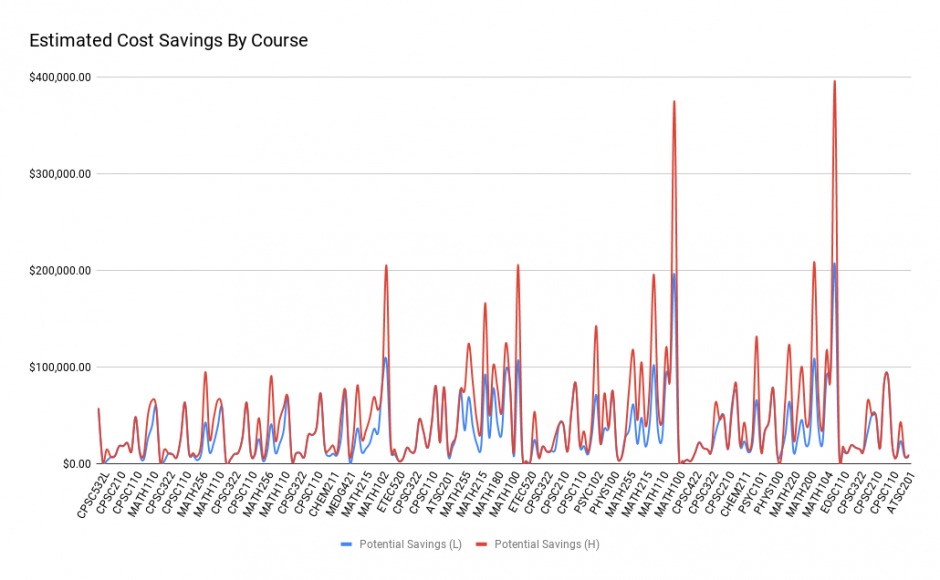Establish a Working Group
7 Create an Inventory of Open
A good place to start as an open working group is to take an inventory of the open educational practices (OEP) at your institution. Engaging in this early on can give you a baseline of both open textbook adoptions and open teaching practices at your institution. This baseline can be used to help you measure the impact of your work advocating for and supporting open practices. It can also be a way for the administration to understand levels of cost savings and start looking at learning impacts. For instructors, creating an inventory is a good way to meet them where they are by sharing and showcasing what they are already doing in the open. Finally, this project can help to locate other individuals, such as early adopters who you may wish to include within the open working group.
A number of institutions and organizations have developed inventories of student cost savings in relation to open educational resources (OER) displacing traditional course textbooks. Determining student savings can engage different stakeholders such as student groups in open education and can help policy makers and institutional leaders understand the value of OER. One example of determining cost savings for students is BCcampus where they use a self-reporting form and a cost calculation to determine students savings from commercial textbook displacement. In 2018, SPARC worked with David Wiley to track student savings in the United States due to OER.[1] This post discusses the methodology that they used and contains links to all of the data.

Approaches to creating an inventory
An inventory may require a lot of conversations and investigative work. Often, the more successful inventories require engaging staff and faculty at a one-on-one level in order to find out what OER work is being done. If you are looking to create an inventory of open at your institution, you can take the following actions:
- Answer 20 Questions to Ask about Open Education [printable PDF] (or use 20 Questions to Ask about Open Education [fillable PDF]). These 20 yes or no questions cover institutional values, knowledge, support, action, and policy and will give the advocates in your institution an indication of where there might be some gaps. To address those gaps, see this searchable database of corresponding open education strategies.
- Survey faculty to determine how they are using OER. (See this 2016 survey of faculty using OER [PDF].)
- Contact OpenStax, BCcampus Open Education, and other open textbook providers to obtain a list of faculty adoptions from your institution.
- Create and distribute a survey, and have instructors report their adoptions.
- Work with the library and the teaching and learning centre to get information about what resources are being included in different courses.
In Practice: Creating an Inventory at UBC
At the University of British Columbia (UBC), the Centre for Teaching, Learning and Technology and the open working group approached the evaluation of OER and OEP initially by trying to get a picture of some of the open practices that instructors were using at UBC. This approach helped to get a baseline of the adoption, adaption, and creation of OER within the institution and made it possible to share examples within UBC and with the larger community.
Developing an inventory for a large and sometimes decentralized research university required using a number of different strategies and approaches:
- They sent out surveys to certain faculties to locate examples of adoption, creation, and adaptation.
- The Faculty Liaisons, a group of staff who work at both the Centre for Teaching, Learning and Technology and individual faculty units, worked with faculty teaching-and-learning units to find examples of OEP.
- They contacted BCcampus and OpenStax to obtain lists of current open textbook adoptions at UBC.
- Based on the activities above, they followed up with individual faculty members and departments to determine specific adoption details.
These time-intensive activities were undertaken primarily by the Open Initiatives Strategist in collaboration with the open working group. The final result was an ongoing series of UBC Open Snapshots that captured the current state of open at the university. In addition, the process revealed potential UBC-student savings between $1.7 and $2.9 million between 2011 and 2016.
Image descriptions
Figure 2 image description: A graph showing high and low cost-savings estimates for fifty UBC courses in 2018. For most courses, savings estimates were under $100,000 per course. Fifteen courses had savings that ranged between $100,000 and $200,000 on the high end. The two courses with the highest estimated potential savings saved students over $350,000 each. [Return to Figure 2]
Media Attributions
- Estimated Cost Savings By Course © Will Engle is licensed under a CC BY (Attribution) license
- Mo Nyamweya, "A New Method for Estimating OER Savings," SPARC, https://sparcopen.org/news/2018/estimating-oer-student-savings/ (accessed January 31, 2019). ↵

